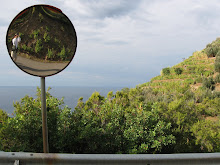Various plants, I understand, have different cell structures that react differently to what seems to me almost magical -- the 32-degree Fahrenheit (0-degree Centigrade) threshold that changes water to ice. The best time where we live to plant garlic is in November, when I take cloves from the previous year's harvest, plant them 2 inches underground and cover with at least 2 inches of mulch. The cloves usually sprout and peek above the ground before winter, then wait until early spring to take off. As one frost after another persists, they seem to laugh as they wait for warmth to return. Onions and chives fare well through the winter, too.
Garlic -- Planted around Garden's Edge
Some of the beets and carrots I planted last fall didn't mature quickly enough, so when cold weather came I covered them with hay. After our 2-month snow blanket melted, I raked off the straw. They're thriving now, with a big head start over my spring-planted beets and carrots.
Beets (over-wintered under hay)
Parsnips? I've read they love to winter over. In fact, some say that's the only way to grow them. The dozen or so I failed to harvest last fall are enjoying the warm weather.
Parsnips
Buttercrunch Lettuce
Testing time! Early this morning, Jack Frost visited. How did my garden fare? Here's some lettuce. Do you see the frost on the leaves, especially on the right and on the leaf edges? (You might have to click on the picture to enlarge it.) It's warm now and doing just fine.
And here's some cauliflower. No problem.
Cauliflower
Peas
"In fact, everything looks fine, except for this," says Virginia.
Volunteer Winter Squash
"Yep, poor thiing," I say. "It volunteered too early, should have known better."









No comments:
Post a Comment